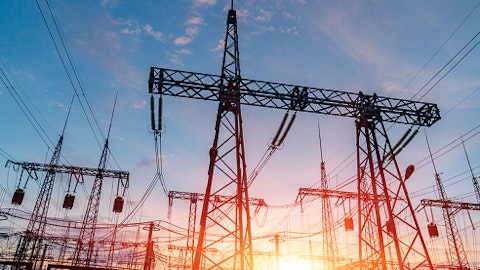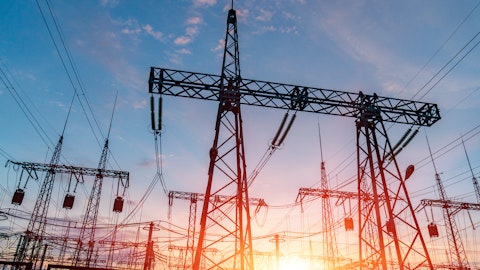Anthony Crowdell: Great. And then if I could think of Jerry, a longer-term question. I know there’s a pending rate case we’re all waiting for a decision. But when you think of the volatility, as you just said, Michigan was the only state in the Midwest that had mild weather. It seems that there’s much more volatility in weather and storm activity, we’re getting in Michigan. It seems every year or 2, there’s a catastrophic storm or an ice form something. I mean when you file your future rate cases, thoughts on maybe the risk return or the risk involved in operating or the challenges in operating the utility in Michigan. Can you maybe change what you think the ROE that unit goes up higher?
Gerardo Norcia: I think 2 things, Anthony. You could go that route which is a more challenging route in terms of lifting ROEs but it’s certainly a possibility, especially in light of rising — continued rising interest rates there will be pressure to move ROEs up in the future. If this interest rate construct continues to get worse or it remains at the levels that it’s at. But I feel that in the past, if you research our history, when we entered periods of very volatile storm activity in order not to whipsaw the level of investment that we can make in our maintenance practices and also capital deployment, there have been storm trackers that have existed in Michigan in the past. And to me, that could be a very viable path going forward.
Operator: Your next question comes from the line of Andrew Weisel with Scotiabank.
Andrew Weisel: I appreciate all the details on the mitigation efforts and the headwinds. Obviously, it’s been a tough year. Most of mine have been answered. Just 2 follow-ups, please. First of all, just to set expectations around the rate case timing. Let’s assume we get a reasonable or normal or constructive outcome, whatever adjective you want to use how soon should we expect the next rate cases? In other words, not trying to get ahead of the current outcome but should we assume the more or less annual filing pace going forward?
Gerardo Norcia: Andrew, I would say that we have an infrastructure recovery mechanism built into the current rate case request. If that’s adopted by the commission which we hope it will be, we will be in annual rate cases until that builds into a large enough infrastructure recovery mechanism for our distribution capital primarily to keep us out of rate cases for longer periods of time. Like if you look at our gas company, we’re able to stay out between 1 and 3 years depending on what’s transpiring inside the gas company but it will reduce the frequency of rate cases if the commission chooses to adopt an infrastructure recovery mechanism, it will just take a couple of years for it to happen until that mechanism built into a large enough amount to track enough capital to keep us out for a while.
Andrew Weisel: That sounds consistent with what you said in the past. Second question is totally unrelated. Question about supply chains. You’re spending a lot of capital both on renewables and on improving reliability. How do you see the availability of these grid level equipment like transformers or switch gears? And if you do see shortages, is there a risk that might slow down your planned pace of spending?
Gerardo Norcia: Well, certainly, we’re very well aware of supply chain challenges with relation to transformers and switch gear and we’ve expanded our reach beyond U.S. borders and are bringing in that equipment from international sources which is working out quite well so far. We’ve done a lot of testing and a lot of investigation and due diligence over the last several years and that’s taken some pressure off of our supply chain. So right now, we feel good about it, Andrew, in terms of how we’re positioned to execute our large capital programs, both on the distribution business as well as the renewables business.
Operator: Your next question comes from the line of Steve Fleishman with Wolfe Research.
Steven Fleishman: Great. So, just — so like in the past, you’ve had rate cases and been able to give guidance in rate case with rate cases pending. So should we think about this being different just because of what happened last year with the surprise in the sales forecast or just tough conditions this year? Just how should we think about what’s different this time versus in the past?
Gerardo Norcia: I would say realistically, Steve, our posture has probably gotten a little more conservative based on what happened last year. And all signals are positive. I mean there’s strong consensus prior to filing the rate case with commissioners and even in their public statements, supporting large levels of investment into the grid and into renewables. We’re also getting that from the governor’s office where there’s strong support for investments in infrastructure. And again, clamoring from customers, as you’ve probably seen, especially this summer wanting for us to invest and make the grid better and also support strong support for the clean energy transition. So we’re likely in a more conservative posture based on the challenges that we’ve had in the regulatory process as well as some of the challenges we’ve experienced this year. So we want to make sure when we tell you we’re going to do something, we’re going to deliver on it.
Steven Fleishman: Okay. And it’s — and how much, if anything is related to just other things than just the rate case? In terms of just wanting to take more time?
Gerardo Norcia: No, we don’t need more time. We just need a data point here to finalize our plans for ’24 and our long-term plan. There’s nothing else really that we’re worried about other than — it’s a significant data point in our plan. And we don’t want to get ahead of our commission.
Operator: Your next question comes from the line of Sophie Karp with KeyBanc.
Sophie Karp: A couple of questions, if I may. With respect to the storm activity, right? So we’ve seen — now it seems like every year, once in a year 50-year storm, right, something like that in different predictions. And is this type of weather volatility increases in UC, now in Michigan, is there in your mind, a need for a more, I guess, structural solution to that? Maybe it should be done to legislature. That goes beyond trackers and riders and what have you but maybe the securitization program for storms some sort of a surcharge on customer bills or storm escrow. All those mechanisms have been employed like in the south where the storms are an annual event. Is there something to learn from that and potentially maybe implement in Michigan?
Gerardo Norcia: I think the straight answer to that and simple answer socket that is absolutely yes. We have to consider all of the above and those are great thoughts that you’ve offered and certainly, we’re thinking about similar approaches as to how to take this volatility out of the plan because as you’ve mentioned, what it does to a utility, when you get into these volatile environments, storm environments as it starts to whipsaw our maintenance plans and potentially even your capital deployment plans. And we don’t want that to happen. We want to make the steady investments and perform the regular maintenance. We need to have in order to run a high-quality grid in a high-quality operation. So very good thoughts. We’re very supportive of your thoughts and we’ll be pursuing them in the future.
Sophie Karp: Got it. And my other question is this, hypothetically speaking, if you were not entirely happy with the rate outcome in the current rate case what is, I guess, a way for you to communicate that to the stakeholders, right? And some of your peers in other jurisdictions when they were in such situations chose to signal that by cutting some of the non-consequential investment but that is politically more charged such as maybe EV infrastructure and things like that. And I was just curious if you’ve given some thoughts as to how you would proceed in that situation?



